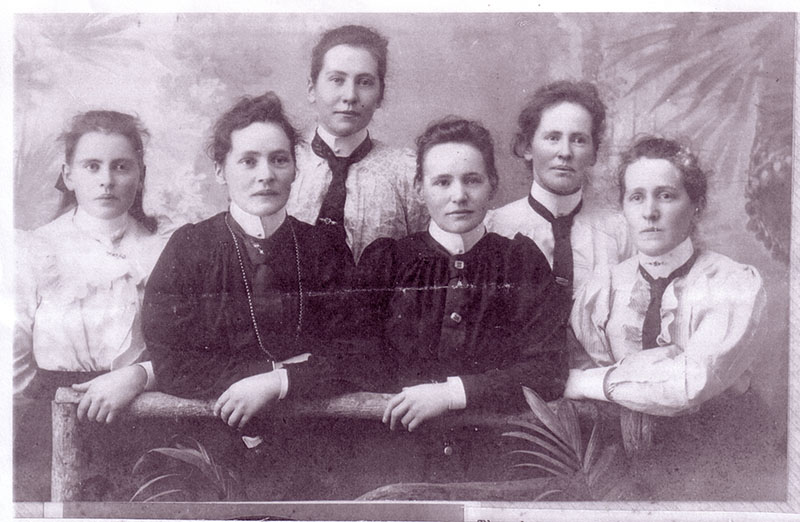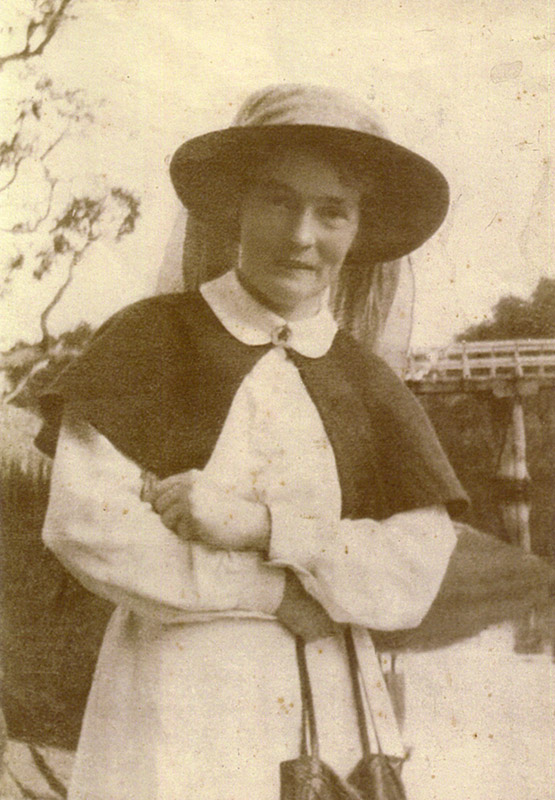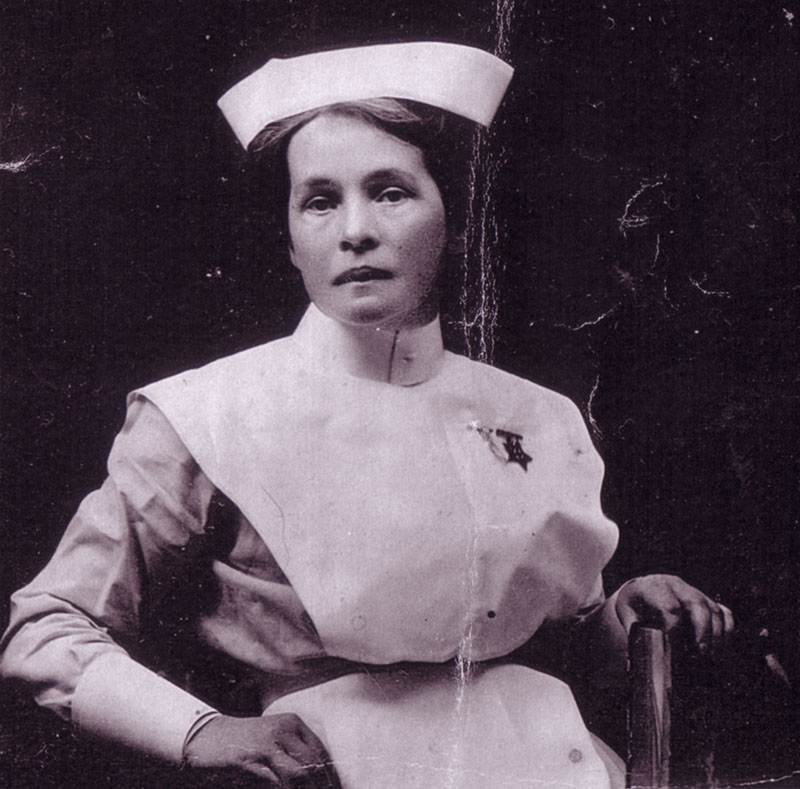





Until the late 1900s women were generally expected to marry. If they didn't, they were labelled a spinster, a word that is often used to describe a rather sad, lonely woman left unfulfilled by life.
Leonora Kelly is described in the cemetery records as spinster, but she chose to become a nurse rather than to marry, and the tale of her Taranaki nursing career demonstrates that her life was neither lonely nor unfulfilled.
Leonora (Nora) was the granddaughter of John and Leonora Kelly who brought their family from the Isle of Man to New Plymouth in 1855. Her father John married Anne Flight in 1867. Nora was the third of their twelve children. She went to school in Lepperton and New Plymouth, and in addition learnt the Manx language from her grandfather.
Although Nora never married she was once engaged. "Most fortunately he broke it off, he was just a cad" wrote her sister Lucy.
When Nora was 33 she went to Timaru to train as a nurse. She worked at Dunedin Hospital, and trained as a midwife at St Helen's Hospital in Christchurch. When she came back to Taranaki it was to work as a backblocks nurse at Urutī.
In the early 1900s many settlers lived in remote areas, working hard to build a life for themselves and future generations. Living far from the town made it difficult to access hospital care when it was needed. After the Government decided to make nursing care available to help these people, the 1909 Hospitals and Charitable Institutions Act allowed Hospital Boards to employ district nurses outside the hospital, on the condition that the community paid half their salary.
Urutī was the first community in New Zealand to use the scheme. It was a hugely isolated area, with only mud roads and no bridges. Some rivers were stony bottomed, while others were mud silt lined with ponga ferns. Settlers moved to these bush areas and literally cut out their farms. Nurse Bilton, the first nurse at Urutī appointed in 1909, describes the living conditions: "Such poverty I have never seen, it is most distressing to live in the midst of it."
Nurse Kelly was the fourth nurse, appointed in May 1912. Her younger sister Nell was the local teacher. As Nora's niece Joyce Clark says, "The nurses worked alone and covered a huge area visiting settlers at home. Their main transport was horseback. Fortunately Nora was a good rider."
In A Night in the Backblocks, she describes an emergency night ride following a bush accident: "We had 10 miles to go: for the first two miles we were able to canter - after that we had to climb up and up until we got to what is called a ridge or razor back, and a very good name too, because the track is so sharp and narrow… it was very muddy and slippery. Great papa slips come down… it was midnight when we reached our destination."
Bush accidents were not uncommon, often caused when trees were felled or through falls from horses. Jean Anderson, ex-resident of Urutī, recalls Nurse Kelly spending two weeks nursing her father after a bush accident when a tree fell on him. He lay unconscious in their house for two weeks during which time Nora spent each night in their home and attended to other duties during the day.
Some of the later nurses could not ride as well as Nora. One, Jean remembers, lasted only a short time - after mounting her horse back-to-front she ended up facing backwards.
The Urutī community came to respect backblock nurses - a respect that was often mirrored in the nurse's regard for them. As Nora writes: "These plucky people deserve all the help the Government can give them - they are the heroes of the Dominion."
The community, with help from the Hospital Board, built a nurses cottage which provided ‘a delightful little home for the District Nurse as well as a ward for her patients’. As there was only one nurse for the area, days off must have been a rare occurrence.
Nora left Urutī after eighteen months of hard work, to do more backblocks nursing in Opunake before venturing onto her next adventure as an army nurse.
Nurses were keen to enlist and serve their country during World War One, which became the first war in which nurses officially accompanied New Zealand Troops. A staggering four hundred women, aged 25 to 45, had volunteered for service by the end of 1914.
When Nora joined the Royal New Zealand Army Nursing Service she declared her age as 45 years 4 months, her height as 5 feet 4 inches and weight 126 pounds.
After enlisting on the 18 January 1916 she was placed on the staff of the Hospital Ship Maheno for its second charter and left Wellington a week later. Before the ship left, an afternoon tea was held for the nurses in the Parliamentary dining room with Prime Minister William Massey, his wife, and Her Excellency Lady Liverpool (wife of the Governor General). Each nurse was presented with badges of the Army Nursing Service.
Following generous donations from the public of New Zealand, the Maheno was extremely well fitted, with fourteen wards, two operating theatres, an X-ray unit and bacteriological laboratory, as well as library, gramophones, chessboards and cards and 14 nurses on the staff.
The ship sailed through a storm to Suez, to pick up wounded and sick soldiers to take back to New Zealand. Afterwards, the Maheno then set sail for England, carrying wounded men to England to be fitted with artificial limbs.
When the Maheno arrived at Southampton there was more to do than fit artificial limbs. The Battle of the Somme had just begun and the ship left for France the very next day, where it was filled ‘from bow to stern’ with wounded men. The decks were turned into wards by hanging canvas screens. The 1141 patients still had mud and dirt from the trenches on them and were so exhausted they could sleep in any position. Everyone was given a mattress to lie on, plenty of blankets and warm food.
With hundreds of wounds to dress, Nora would later write: "There and then began labours that never ended night or day, irregular meals and short hours of sleep". Nora was one of just 14 nurses assisted by orderlies.
The Maheno continued to cross the English Channel ferrying wounded soldiers to Southampton. Between July 4 and October 28, 1916, at least 21 journeys were made carrying around 15,000 patients and prisoners of war. Seven return trips were made in a single day. Constant danger from mines and submarines meant frequent alterations of course. Sometimes the passage was blocked and the ship had to wait, fully loaded, for days.
Discharged from the Army in 1920, Nora earned both the British War Medal and the Victory Medal and her name appears on the memorial board in Marama Hall, University of Otago.
There seems to be limited information regarding Nora's career after her discharge from the Army. She may have taken a well-earned rest before beginning work in a variety of short-term jobs before her appointment as Matron of Pātea Hospital in October 1920.
At the time, Pātea was a thriving country town with a port, freezing works, and around 40 shops in the main street. The hospital was well equipped for its size and supported by the community. Dr Simmons, aside from a short break to service in the Medical Corps, was medical superintendent of the hospital from 1904 until 1946.
In the Nurses Home, Nora lived in her own flat. Other staff included a cook, a laundress who was employed one day a week (who used a copper until 1927) and a porter who also ran the hospital farm and vegetable garden, milked cows and cut firewood. The hospital boasted separate wards for men and women, and small fever and maternity annexes.
Two women remember Nora from her time at Pātea. One is Helen Fraser, the daughter of Nurse Fraser, a previous sister at the hospital and Nora's great friend. She remembers ‘Aunt Nora’ as a family friend who spent many of her days off at their farm, generally staying late enough for dinner.
"She used to giggle a lot, always saw the funny side of things, when she got the giggles she became hysterical" Helen says. "One day the races were on, (we had a racehorse, and we loved to follow the horses, so did she), she came to stay. There was a knock on the door and the Presbyterian minister came to call. 'What are you doing little girl?' he asked. I replied, 'I'm picking the winners at the races.' Aunt Nora put her hands up to her face, burst into laughter, then disappeared outside till he'd gone."
Another, Mickey Edwards, a Pātea pupil nurse from 1929 to 1931, remembers Matron Kelly as a wonderful woman who was like a mother to the students, strict but fair and caring. "They dined together, like a family, and Matron always served the food and made sure they ate properly. The nurses had one late night a month and she made sure they were in on time. Before the Hospital Ball she liked the nurses to present themselves to her, in their long dresses, with their partners. Once a year they all went on a picnic up Mount Taranaki."
In 1931, Mickey was asleep in the Nurses Home when the Hawke's Bay Earthquake occurred and Matron immediately sent someone over to see if they were all right. "All the nurses loved Matron very much because she was so dedicated to her nursing, and though they knew she had served in the Army she never spoke about it." Mickey speaks of Matron as a very social woman who was most popular in the local community, a keen follower of horse racing and a great bridge player. She would organise bridge parties in her lounge and have the students bring in the coffee.
An old photo from Pātea Hospital bears a caption describing Matron Kelly as ‘Calamity Kate, the Galloping Chestnut’. Mickey says Dr Simmons always called her ‘Calamity Kate’ and ‘galloping’ probably refers to the fact that Dr Simmons was a tall man who walked fast with big strides, whereas Matron took little steps (like a trot) and had to gallop to keep up with him on his rounds.
"As to the ‘chestnut’ part, well, her hair was chestnut-coloured, but the nurses knew that it was actually silver and they used to watch as Matron, who was well into her fifties by now, dried her newly dyed hair under the trees in the hospital grounds."
Another, somewhat different image of Nora comes from her niece Marjorie, Nell's daughter, who spent time in Pātea Hospital as a child with appendicitis and once wrote: "Every morning they had a parade of doctors and nurses through the wards, Aunt Nora galloping along behind. Everything had to be done very correctly. The doctors were little kings then. She was a lively sort of a person but she never did anything for herself if a nurse could do it. She loved her bridge parties and she'd be sitting smoking inside on a lovely summer's day."
Her family also tell a story about Nora's earliest days Pātea, when a local woman brought her sick daughter to the hospital and remarked on her satisfaction at finally finding a Catholic nurse. The reply from Nora was along the lines that the child would make a good recovery despite being a Catholic.
A delightful account written of Christmas Day at Pātea Hospital by Nora describes how the staff provided decorations, presents (including tobacco), entertainment and food for the patients.
Nora retired to Fitzroy in New Plymouth where family and friends visited her regularly. Helen Rodgers remembers Nora swimming with them every day in the summer though Joyce Clark recalls her visits as rather more formal affairs.
Leonora Flight Kelly died on 22 August 1949 and was buried in Te Hēnui cemetery alongside her sister Kate where, sadly adhering to the traditions of the time, the cemetery recorded her occupation as spinster. Born in 1870, she was 79 when she died.
Her death notice reads: ‘Kelly - On August 22, 1949, at her residence, 27 Hamblyn Street, Fitzroy, New Plymouth, Leonora Flight, dearly loved daughter of the late John and Anne Kelly. At rest.’
Puke Ariki Heritage Collection: Leonora Flight Kelly
LinkPlease do not reproduce these images without permission from Puke Ariki.
Contact us for more information or you can order images online here.